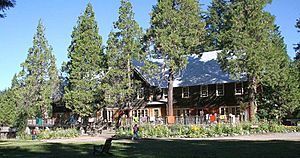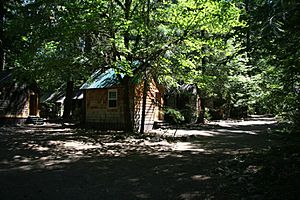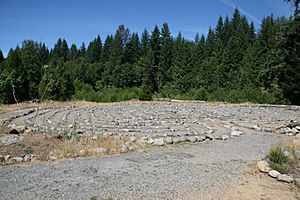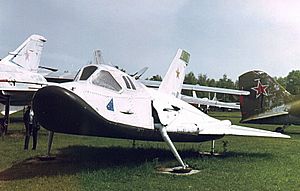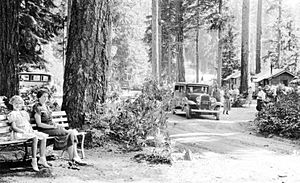Breitenbush Hot Springs facts for kids
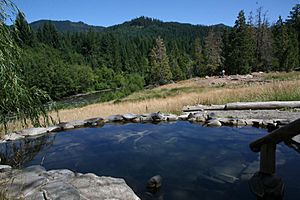
View From Breitenbush Meadow Pool
|
|
| Mission | "To provide a safe and potent environment where people can change and evolve in ways they never imagined." |
|---|---|
| Focus | Humanism, Sustainability, Community |
| Location | , , |
| Coordinates | 44°46′59″N 121°58′40″W / 44.783061°N 121.9777805°W |
| Address | 53000 Breitenbush Rd |
| Website | Breitenbush.com |
Breitenbush Hot Springs Retreat & Conference Center (say it: BRIGHT en BUSH) is a special place in Oregon, United States. It is often called Breitenbush Hot Springs or just Breitenbush. This center is a worker-owned business, meaning the people who work there also own and run it.
Breitenbush is known for its holistic (focusing on the whole person) and spiritual retreats. It is surrounded by the beautiful Willamette National Forest. You can find it about 10 miles (16 km) east of Detroit. The closest big city is Salem, which is about 60 miles (97 km) away. The retreat center is built around natural hot springs. These springs flow into the nearby Breitenbush River.
In September 2020, Breitenbush had to be evacuated. It was badly damaged by the Santiam Fire. Many cabins and other buildings were hurt. Because of this, it is currently closed to visitors and residents.
Contents
About the Retreat Center
Breitenbush is famous for hosting many workshops. These workshops focus on topics like holistic health, spiritual growth, and New Age ideas. Before the fire, most workshops were open to anyone who made a reservation. People also visited for quiet meditation or just to relax.
The current retreat center started in 1981. Visitors could enjoy pools and tubs filled with hot spring water. There was also a steam sauna and healthy meals. Staff members often led special programs. You could also explore over 20 miles (32 km) of hiking trails nearby.
Other facilities included a main lodge, cozy guest cabins, and places to set up tents in the summer. There was also a walking labyrinth for meditation, a quiet sanctuary, and a gift shop. Sadly, most of these were destroyed in the fire.
A very important value at Breitenbush is Sustainability. This means they try to live in a way that protects the environment. The center makes its own electricity. It uses a hydroelectric power plant that is cared for by the employees. This plant uses the power of moving water to create energy. Diesel generators are used as a backup. Breitenbush is the biggest private place in the Pacific Northwest that uses geothermal energy. Because it is so far out in nature, cell phones usually do not work there. You also cannot get regular radio or TV signals.
Workshops and Activities
Before the COVID-19 pandemic, Breitenbush hosted about 150 workshops every year. The center provided the space for these events. The workshops were led by different people and covered many topics. Most of them focused on good values and caring for nature.
Examples of workshops included:
- Yoga teacher training
- Conferences about mushrooms, herbs, or farming
- Singing, dancing, and art classes
- Learning about fair business practices
- Nutrition and wellness programs
Soaking in the Hot Springs
There are many ways to enjoy the hot springs at Breitenbush. You can soak in three rock-lined pools. Each pool can comfortably fit up to ten people. There is also a cedar sauna that can hold up to 12 people.
In a concrete patio area, there are four hot tubs. Each of these can seat about four people. For a more private experience, there are also several smaller claw-foot bathtubs. These are perfect for one person to soak in.
How the Hot Springs Work
The hot springs at Breitenbush get their heat from deep inside the Earth. Rainwater falls onto the surrounding Cascade Range mountains. This water then seeps deep into the ground. It travels for thousands of years. As it goes deeper, it gets very hot, reaching about 356°F (180°C).
The hot water picks up many dissolved minerals from the rocks. These minerals include things like sulfate, calcite, and quartz. When the water comes back to the surface, it is still very hot, around 180°F (82°C). It cools down a bit as it gets closer to the surface.
The Breitenbush Community
How it Started
The community that runs Breitenbush has been managing the location since 1977. Before that, different businesses tried to run a resort there. Many of them struggled with harsh winters and floods. The last resort closed in 1972 after a series of floods.
Then, a person named Alex Beamer bought the land. He had a vision for an intentional community. This is a group of people who choose to live together and share common goals. He started inviting others to help him fix up the property. In the early days, the community members worked hard for their beliefs. They also received a place to live and a small amount of money.
They worked to fix the hydroelectric plant. They also dug geothermal wells to bring heat to the buildings. A dam and a footbridge were built across the river. They also improved the hot springs soaking areas and built workshop spaces. This helped them create a health-focused retreat center. The community was very egalitarian. This means everyone was treated equally. Residents did all kinds of jobs, from skilled work to daily chores.
Logging companies wanted to cut down trees around Breitenbush. This was a big threat to the area. The community members worked hard to stop the logging. Many became activists. They helped protect the surrounding forests. They even found a pair of spotted owls, which were a protected species. This helped them stop logging operations.
In the early years, worker-residents often did not get paid much. Many had other jobs to make enough money to live. Historian James J. Kopp says that Breitenbush was part of a trend. Many utopian and counter-cultural groups became popular in the 1960s and 1970s.
Alex Beamer sold the property to the community members in 1985. The business officially became a worker-owned cooperative in 1989. The way it was managed continued to follow the co-op's original values. Decisions were made by everyone agreeing.
How it Works Now
Before the 2020 evacuation, about 50 to 70 people lived in the community village year-round. This included workers and their families. The site covers about 154 acres (0.62 km²).
New members join the co-op after working there for a year. They also buy a share in the business. The members of the cooperative have the final say on important issues. They vote in meetings twice a year. Daily operations are handled by a Board of Directors and managing staff. The Board members are chosen from the resident members.
The community gets all its money from the retreat center. Adult members are expected to help with the daily business operations. They earn minimum wage. However, they also get many benefits. These include housing, utilities, food, vacation time, and health care.
Early History
Trappers from the Hudson's Bay Company first found Breitenbush. Later, a person named Claude Mansfield settled there. He received the land patent on August 16, 1904, from President Theodore Roosevelt.
John Minto explored the Santiam River area in 1874. He named the area "Breitenbush" after Lewis Breitenbucher. Lewis was a one-armed hunter who lived there. Minto remembered the name incorrectly, but "Breitenbush" has been used ever since.
In 1927, Merle Bruckman bought the site. He built a resort and ran it for about 20 years. This was a very popular time for the hot springs. After that, different people managed the resort. It finally closed in 1972.
Gallery
Images for kids



